Investigating the Effect of Nanoclay on Concrete Mechanical Properties
VerifiedAdded on 2020/04/01
|31
|8201
|52
Report
AI Summary
This report delves into the effects of incorporating nanoclay into concrete, a practice gaining traction for its potential to enhance mechanical properties. The study examines how nanoclay, particularly smectite clay like montmorillonite, improves traits such as tensile and flexural strength, thermal stability, solvent resistance, and flame retardancy. It explores the self-healing properties of nanoclay-infused concrete, where microcapsules release healing agents to close cracks. The report presents experimental studies, including compressive, split tensile, and flexural strength tests, with results showing significant improvements in strength compared to plain cement mortars. Various experiments are discussed, including those using nano-metakaolin and calcined nanoclay, demonstrating the positive correlation between nanoclay addition and enhanced compressive and tensile strengths. The report concludes that nanoclay addition can lead to smarter, more durable cementitious composites with reduced pollution and improved thermal insulation.
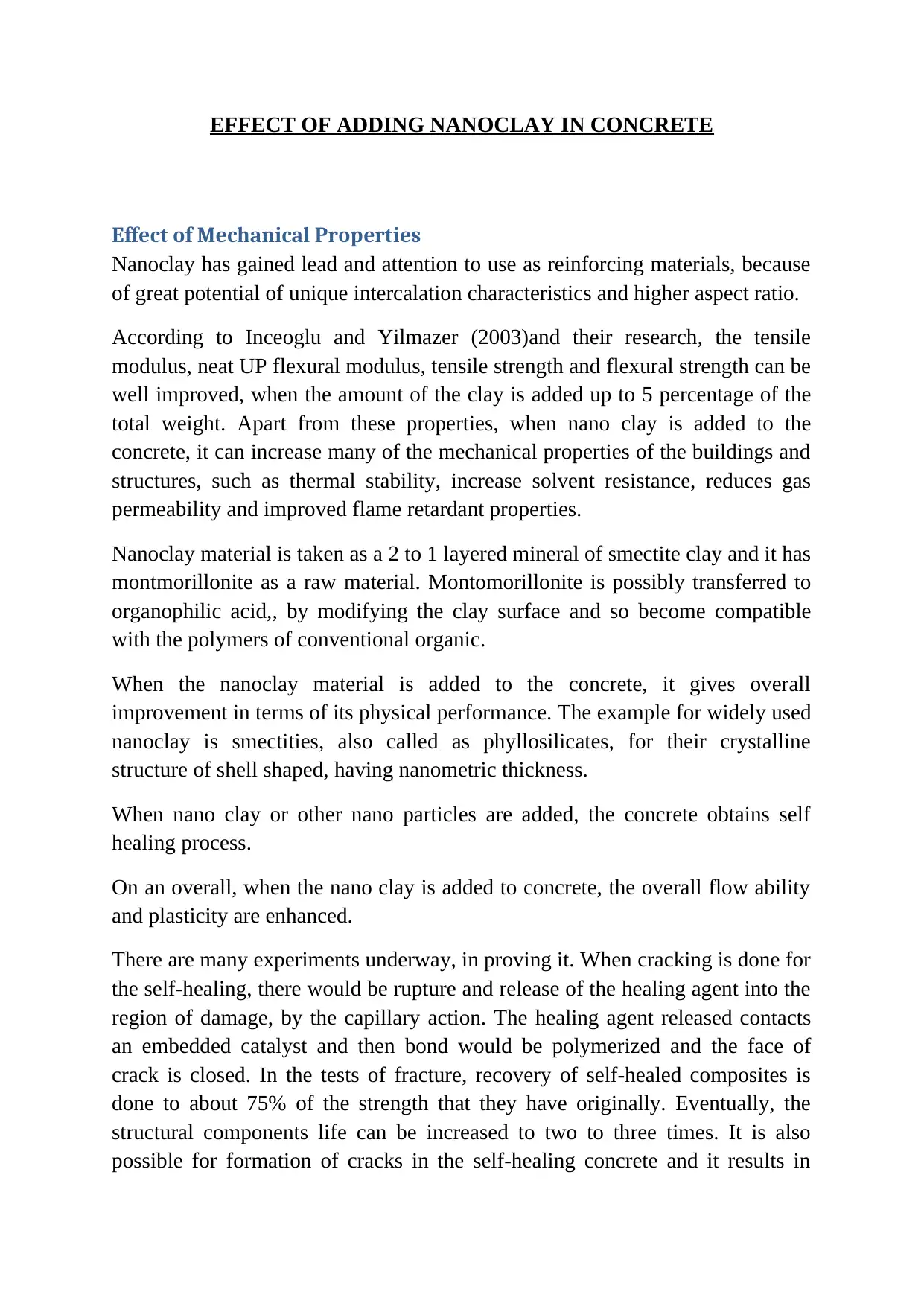
EFFECT OF ADDING NANOCLAY IN CONCRETE
Effect of Mechanical Properties
Nanoclay has gained lead and attention to use as reinforcing materials, because
of great potential of unique intercalation characteristics and higher aspect ratio.
According to Inceoglu and Yilmazer (2003)and their research, the tensile
modulus, neat UP flexural modulus, tensile strength and flexural strength can be
well improved, when the amount of the clay is added up to 5 percentage of the
total weight. Apart from these properties, when nano clay is added to the
concrete, it can increase many of the mechanical properties of the buildings and
structures, such as thermal stability, increase solvent resistance, reduces gas
permeability and improved flame retardant properties.
Nanoclay material is taken as a 2 to 1 layered mineral of smectite clay and it has
montmorillonite as a raw material. Montomorillonite is possibly transferred to
organophilic acid,, by modifying the clay surface and so become compatible
with the polymers of conventional organic.
When the nanoclay material is added to the concrete, it gives overall
improvement in terms of its physical performance. The example for widely used
nanoclay is smectities, also called as phyllosilicates, for their crystalline
structure of shell shaped, having nanometric thickness.
When nano clay or other nano particles are added, the concrete obtains self
healing process.
On an overall, when the nano clay is added to concrete, the overall flow ability
and plasticity are enhanced.
There are many experiments underway, in proving it. When cracking is done for
the self-healing, there would be rupture and release of the healing agent into the
region of damage, by the capillary action. The healing agent released contacts
an embedded catalyst and then bond would be polymerized and the face of
crack is closed. In the tests of fracture, recovery of self-healed composites is
done to about 75% of the strength that they have originally. Eventually, the
structural components life can be increased to two to three times. It is also
possible for formation of cracks in the self-healing concrete and it results in
Effect of Mechanical Properties
Nanoclay has gained lead and attention to use as reinforcing materials, because
of great potential of unique intercalation characteristics and higher aspect ratio.
According to Inceoglu and Yilmazer (2003)and their research, the tensile
modulus, neat UP flexural modulus, tensile strength and flexural strength can be
well improved, when the amount of the clay is added up to 5 percentage of the
total weight. Apart from these properties, when nano clay is added to the
concrete, it can increase many of the mechanical properties of the buildings and
structures, such as thermal stability, increase solvent resistance, reduces gas
permeability and improved flame retardant properties.
Nanoclay material is taken as a 2 to 1 layered mineral of smectite clay and it has
montmorillonite as a raw material. Montomorillonite is possibly transferred to
organophilic acid,, by modifying the clay surface and so become compatible
with the polymers of conventional organic.
When the nanoclay material is added to the concrete, it gives overall
improvement in terms of its physical performance. The example for widely used
nanoclay is smectities, also called as phyllosilicates, for their crystalline
structure of shell shaped, having nanometric thickness.
When nano clay or other nano particles are added, the concrete obtains self
healing process.
On an overall, when the nano clay is added to concrete, the overall flow ability
and plasticity are enhanced.
There are many experiments underway, in proving it. When cracking is done for
the self-healing, there would be rupture and release of the healing agent into the
region of damage, by the capillary action. The healing agent released contacts
an embedded catalyst and then bond would be polymerized and the face of
crack is closed. In the tests of fracture, recovery of self-healed composites is
done to about 75% of the strength that they have originally. Eventually, the
structural components life can be increased to two to three times. It is also
possible for formation of cracks in the self-healing concrete and it results in
Paraphrase This Document
Need a fresh take? Get an instant paraphrase of this document with our AI Paraphraser
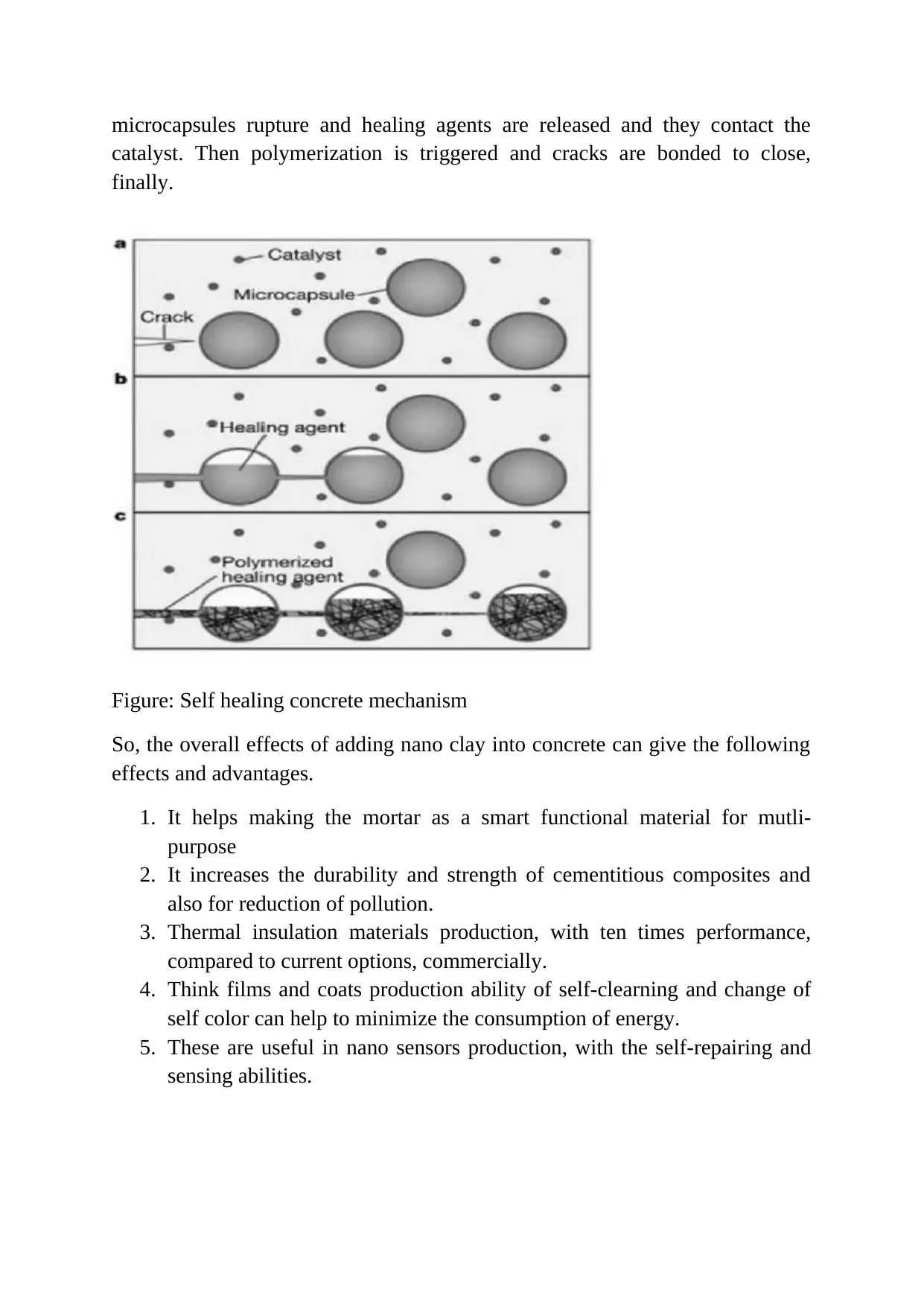
microcapsules rupture and healing agents are released and they contact the
catalyst. Then polymerization is triggered and cracks are bonded to close,
finally.
Figure: Self healing concrete mechanism
So, the overall effects of adding nano clay into concrete can give the following
effects and advantages.
1. It helps making the mortar as a smart functional material for mutli-
purpose
2. It increases the durability and strength of cementitious composites and
also for reduction of pollution.
3. Thermal insulation materials production, with ten times performance,
compared to current options, commercially.
4. Think films and coats production ability of self-clearning and change of
self color can help to minimize the consumption of energy.
5. These are useful in nano sensors production, with the self-repairing and
sensing abilities.
catalyst. Then polymerization is triggered and cracks are bonded to close,
finally.
Figure: Self healing concrete mechanism
So, the overall effects of adding nano clay into concrete can give the following
effects and advantages.
1. It helps making the mortar as a smart functional material for mutli-
purpose
2. It increases the durability and strength of cementitious composites and
also for reduction of pollution.
3. Thermal insulation materials production, with ten times performance,
compared to current options, commercially.
4. Think films and coats production ability of self-clearning and change of
self color can help to minimize the consumption of energy.
5. These are useful in nano sensors production, with the self-repairing and
sensing abilities.
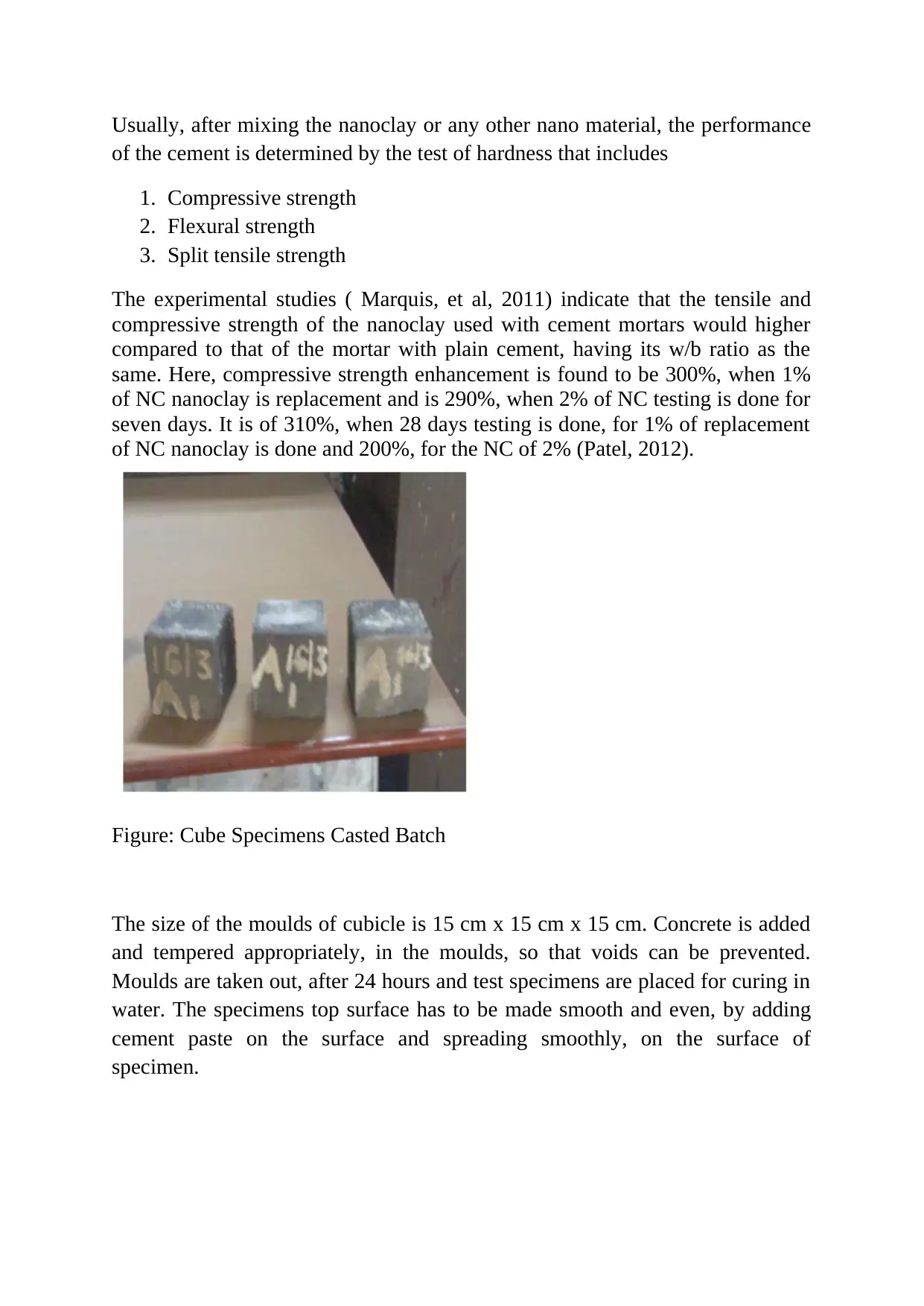
Usually, after mixing the nanoclay or any other nano material, the performance
of the cement is determined by the test of hardness that includes
1. Compressive strength
2. Flexural strength
3. Split tensile strength
The experimental studies ( Marquis, et al, 2011) indicate that the tensile and
compressive strength of the nanoclay used with cement mortars would higher
compared to that of the mortar with plain cement, having its w/b ratio as the
same. Here, compressive strength enhancement is found to be 300%, when 1%
of NC nanoclay is replacement and is 290%, when 2% of NC testing is done for
seven days. It is of 310%, when 28 days testing is done, for 1% of replacement
of NC nanoclay is done and 200%, for the NC of 2% (Patel, 2012).
Figure: Cube Specimens Casted Batch
The size of the moulds of cubicle is 15 cm x 15 cm x 15 cm. Concrete is added
and tempered appropriately, in the moulds, so that voids can be prevented.
Moulds are taken out, after 24 hours and test specimens are placed for curing in
water. The specimens top surface has to be made smooth and even, by adding
cement paste on the surface and spreading smoothly, on the surface of
specimen.
of the cement is determined by the test of hardness that includes
1. Compressive strength
2. Flexural strength
3. Split tensile strength
The experimental studies ( Marquis, et al, 2011) indicate that the tensile and
compressive strength of the nanoclay used with cement mortars would higher
compared to that of the mortar with plain cement, having its w/b ratio as the
same. Here, compressive strength enhancement is found to be 300%, when 1%
of NC nanoclay is replacement and is 290%, when 2% of NC testing is done for
seven days. It is of 310%, when 28 days testing is done, for 1% of replacement
of NC nanoclay is done and 200%, for the NC of 2% (Patel, 2012).
Figure: Cube Specimens Casted Batch
The size of the moulds of cubicle is 15 cm x 15 cm x 15 cm. Concrete is added
and tempered appropriately, in the moulds, so that voids can be prevented.
Moulds are taken out, after 24 hours and test specimens are placed for curing in
water. The specimens top surface has to be made smooth and even, by adding
cement paste on the surface and spreading smoothly, on the surface of
specimen.
⊘ This is a preview!⊘
Do you want full access?
Subscribe today to unlock all pages.

Trusted by 1+ million students worldwide
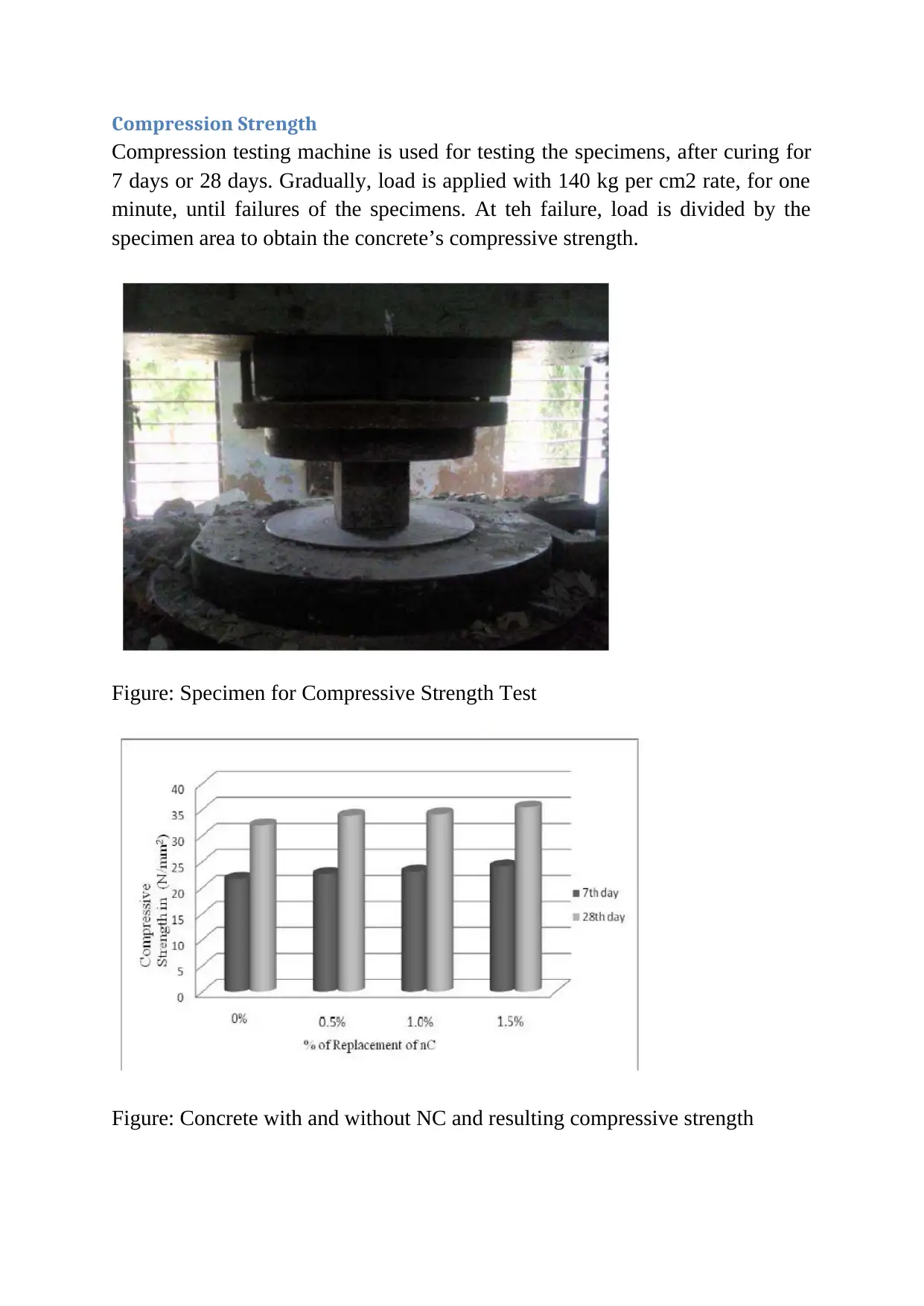
Compression Strength
Compression testing machine is used for testing the specimens, after curing for
7 days or 28 days. Gradually, load is applied with 140 kg per cm2 rate, for one
minute, until failures of the specimens. At teh failure, load is divided by the
specimen area to obtain the concrete’s compressive strength.
Figure: Specimen for Compressive Strength Test
Figure: Concrete with and without NC and resulting compressive strength
Compression testing machine is used for testing the specimens, after curing for
7 days or 28 days. Gradually, load is applied with 140 kg per cm2 rate, for one
minute, until failures of the specimens. At teh failure, load is divided by the
specimen area to obtain the concrete’s compressive strength.
Figure: Specimen for Compressive Strength Test
Figure: Concrete with and without NC and resulting compressive strength
Paraphrase This Document
Need a fresh take? Get an instant paraphrase of this document with our AI Paraphraser
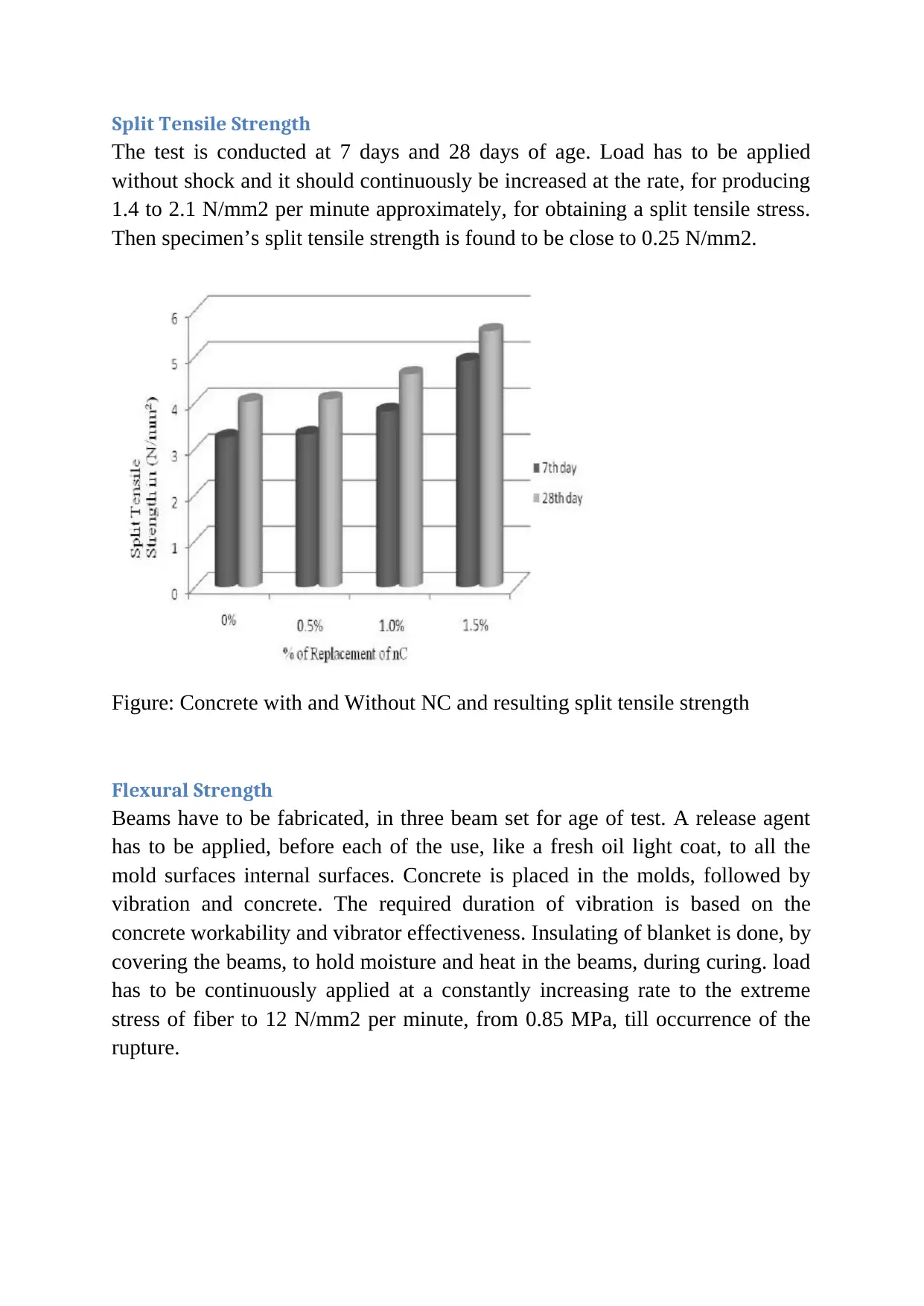
Split Tensile Strength
The test is conducted at 7 days and 28 days of age. Load has to be applied
without shock and it should continuously be increased at the rate, for producing
1.4 to 2.1 N/mm2 per minute approximately, for obtaining a split tensile stress.
Then specimen’s split tensile strength is found to be close to 0.25 N/mm2.
Figure: Concrete with and Without NC and resulting split tensile strength
Flexural Strength
Beams have to be fabricated, in three beam set for age of test. A release agent
has to be applied, before each of the use, like a fresh oil light coat, to all the
mold surfaces internal surfaces. Concrete is placed in the molds, followed by
vibration and concrete. The required duration of vibration is based on the
concrete workability and vibrator effectiveness. Insulating of blanket is done, by
covering the beams, to hold moisture and heat in the beams, during curing. load
has to be continuously applied at a constantly increasing rate to the extreme
stress of fiber to 12 N/mm2 per minute, from 0.85 MPa, till occurrence of the
rupture.
The test is conducted at 7 days and 28 days of age. Load has to be applied
without shock and it should continuously be increased at the rate, for producing
1.4 to 2.1 N/mm2 per minute approximately, for obtaining a split tensile stress.
Then specimen’s split tensile strength is found to be close to 0.25 N/mm2.
Figure: Concrete with and Without NC and resulting split tensile strength
Flexural Strength
Beams have to be fabricated, in three beam set for age of test. A release agent
has to be applied, before each of the use, like a fresh oil light coat, to all the
mold surfaces internal surfaces. Concrete is placed in the molds, followed by
vibration and concrete. The required duration of vibration is based on the
concrete workability and vibrator effectiveness. Insulating of blanket is done, by
covering the beams, to hold moisture and heat in the beams, during curing. load
has to be continuously applied at a constantly increasing rate to the extreme
stress of fiber to 12 N/mm2 per minute, from 0.85 MPa, till occurrence of the
rupture.
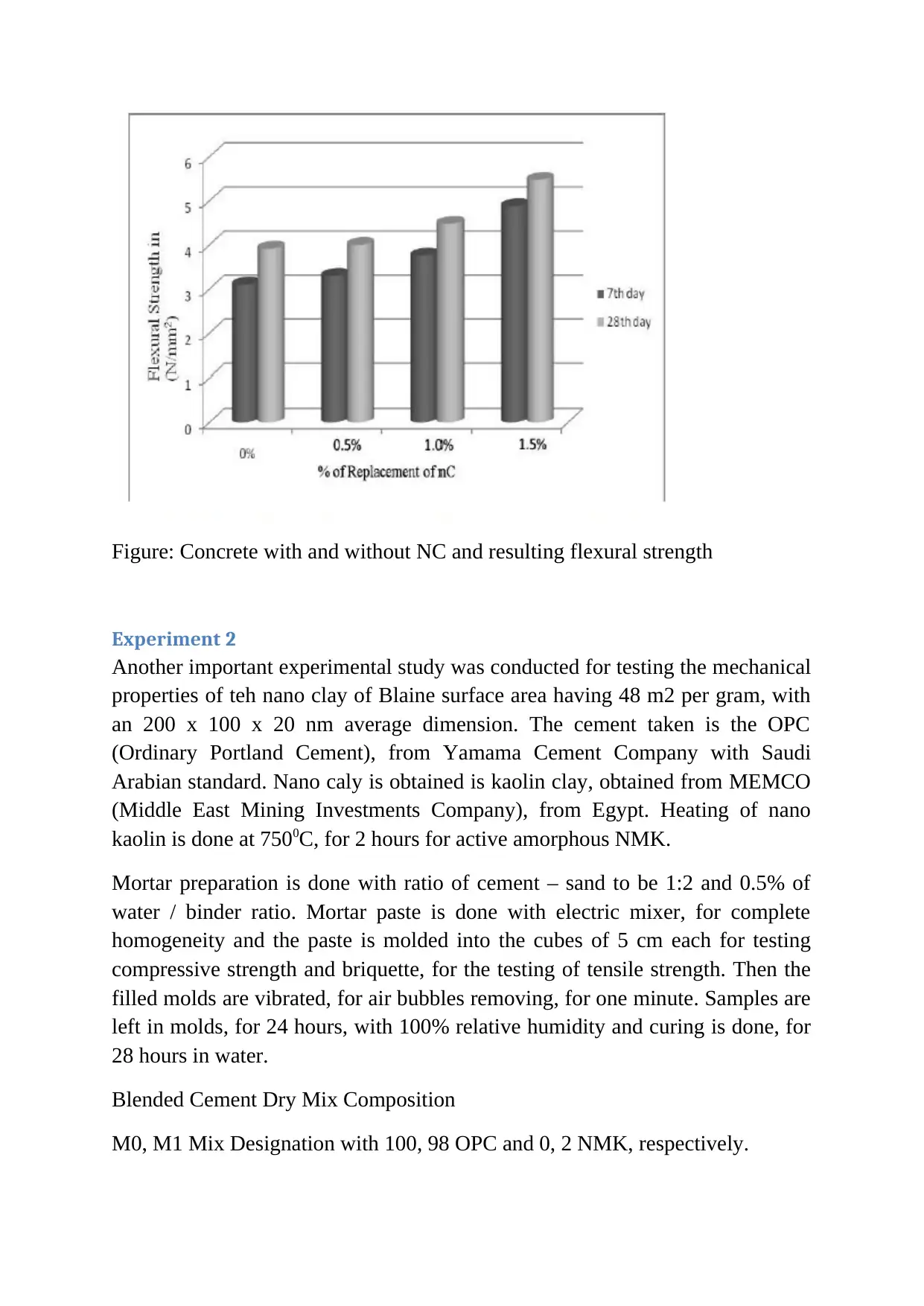
Figure: Concrete with and without NC and resulting flexural strength
Experiment 2
Another important experimental study was conducted for testing the mechanical
properties of teh nano clay of Blaine surface area having 48 m2 per gram, with
an 200 x 100 x 20 nm average dimension. The cement taken is the OPC
(Ordinary Portland Cement), from Yamama Cement Company with Saudi
Arabian standard. Nano caly is obtained is kaolin clay, obtained from MEMCO
(Middle East Mining Investments Company), from Egypt. Heating of nano
kaolin is done at 7500C, for 2 hours for active amorphous NMK.
Mortar preparation is done with ratio of cement – sand to be 1:2 and 0.5% of
water / binder ratio. Mortar paste is done with electric mixer, for complete
homogeneity and the paste is molded into the cubes of 5 cm each for testing
compressive strength and briquette, for the testing of tensile strength. Then the
filled molds are vibrated, for air bubbles removing, for one minute. Samples are
left in molds, for 24 hours, with 100% relative humidity and curing is done, for
28 hours in water.
Blended Cement Dry Mix Composition
M0, M1 Mix Designation with 100, 98 OPC and 0, 2 NMK, respectively.
Experiment 2
Another important experimental study was conducted for testing the mechanical
properties of teh nano clay of Blaine surface area having 48 m2 per gram, with
an 200 x 100 x 20 nm average dimension. The cement taken is the OPC
(Ordinary Portland Cement), from Yamama Cement Company with Saudi
Arabian standard. Nano caly is obtained is kaolin clay, obtained from MEMCO
(Middle East Mining Investments Company), from Egypt. Heating of nano
kaolin is done at 7500C, for 2 hours for active amorphous NMK.
Mortar preparation is done with ratio of cement – sand to be 1:2 and 0.5% of
water / binder ratio. Mortar paste is done with electric mixer, for complete
homogeneity and the paste is molded into the cubes of 5 cm each for testing
compressive strength and briquette, for the testing of tensile strength. Then the
filled molds are vibrated, for air bubbles removing, for one minute. Samples are
left in molds, for 24 hours, with 100% relative humidity and curing is done, for
28 hours in water.
Blended Cement Dry Mix Composition
M0, M1 Mix Designation with 100, 98 OPC and 0, 2 NMK, respectively.
⊘ This is a preview!⊘
Do you want full access?
Subscribe today to unlock all pages.

Trusted by 1+ million students worldwide
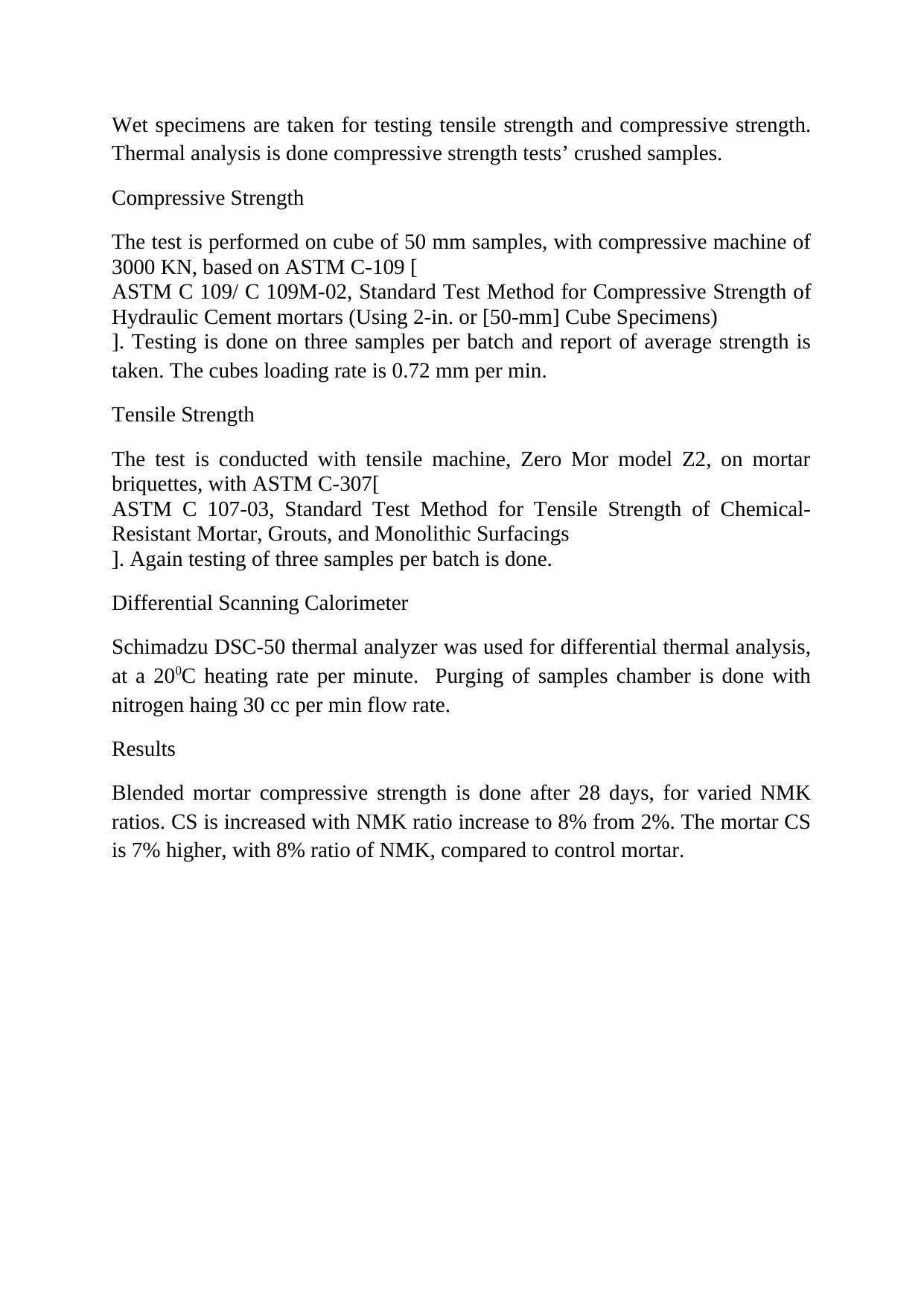
Wet specimens are taken for testing tensile strength and compressive strength.
Thermal analysis is done compressive strength tests’ crushed samples.
Compressive Strength
The test is performed on cube of 50 mm samples, with compressive machine of
3000 KN, based on ASTM C-109 [
ASTM C 109/ C 109M-02, Standard Test Method for Compressive Strength of
Hydraulic Cement mortars (Using 2-in. or [50-mm] Cube Specimens)
]. Testing is done on three samples per batch and report of average strength is
taken. The cubes loading rate is 0.72 mm per min.
Tensile Strength
The test is conducted with tensile machine, Zero Mor model Z2, on mortar
briquettes, with ASTM C-307[
ASTM C 107-03, Standard Test Method for Tensile Strength of Chemical-
Resistant Mortar, Grouts, and Monolithic Surfacings
]. Again testing of three samples per batch is done.
Differential Scanning Calorimeter
Schimadzu DSC-50 thermal analyzer was used for differential thermal analysis,
at a 200C heating rate per minute. Purging of samples chamber is done with
nitrogen haing 30 cc per min flow rate.
Results
Blended mortar compressive strength is done after 28 days, for varied NMK
ratios. CS is increased with NMK ratio increase to 8% from 2%. The mortar CS
is 7% higher, with 8% ratio of NMK, compared to control mortar.
Thermal analysis is done compressive strength tests’ crushed samples.
Compressive Strength
The test is performed on cube of 50 mm samples, with compressive machine of
3000 KN, based on ASTM C-109 [
ASTM C 109/ C 109M-02, Standard Test Method for Compressive Strength of
Hydraulic Cement mortars (Using 2-in. or [50-mm] Cube Specimens)
]. Testing is done on three samples per batch and report of average strength is
taken. The cubes loading rate is 0.72 mm per min.
Tensile Strength
The test is conducted with tensile machine, Zero Mor model Z2, on mortar
briquettes, with ASTM C-307[
ASTM C 107-03, Standard Test Method for Tensile Strength of Chemical-
Resistant Mortar, Grouts, and Monolithic Surfacings
]. Again testing of three samples per batch is done.
Differential Scanning Calorimeter
Schimadzu DSC-50 thermal analyzer was used for differential thermal analysis,
at a 200C heating rate per minute. Purging of samples chamber is done with
nitrogen haing 30 cc per min flow rate.
Results
Blended mortar compressive strength is done after 28 days, for varied NMK
ratios. CS is increased with NMK ratio increase to 8% from 2%. The mortar CS
is 7% higher, with 8% ratio of NMK, compared to control mortar.
Paraphrase This Document
Need a fresh take? Get an instant paraphrase of this document with our AI Paraphraser
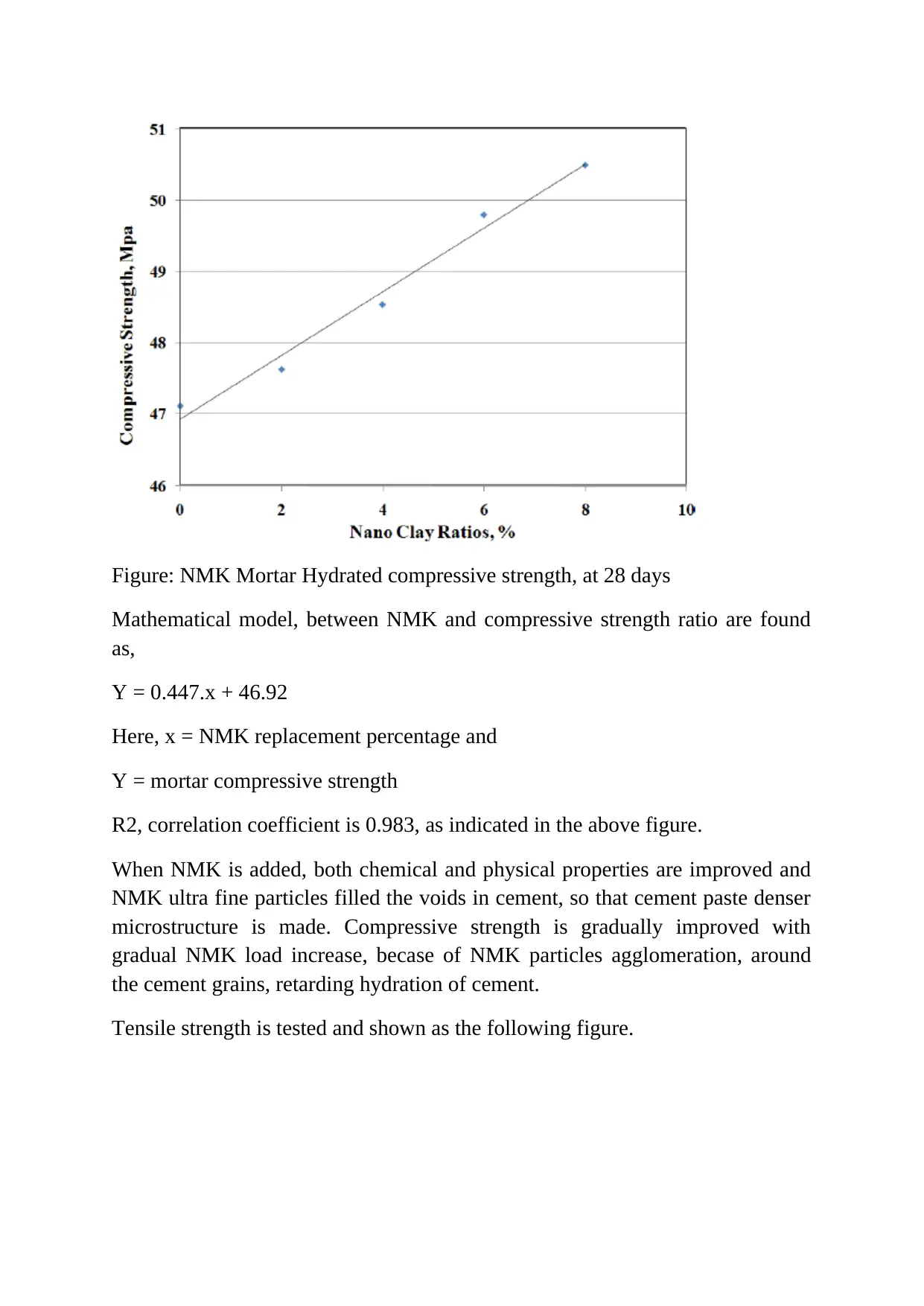
Figure: NMK Mortar Hydrated compressive strength, at 28 days
Mathematical model, between NMK and compressive strength ratio are found
as,
Y = 0.447.x + 46.92
Here, x = NMK replacement percentage and
Y = mortar compressive strength
R2, correlation coefficient is 0.983, as indicated in the above figure.
When NMK is added, both chemical and physical properties are improved and
NMK ultra fine particles filled the voids in cement, so that cement paste denser
microstructure is made. Compressive strength is gradually improved with
gradual NMK load increase, becase of NMK particles agglomeration, around
the cement grains, retarding hydration of cement.
Tensile strength is tested and shown as the following figure.
Mathematical model, between NMK and compressive strength ratio are found
as,
Y = 0.447.x + 46.92
Here, x = NMK replacement percentage and
Y = mortar compressive strength
R2, correlation coefficient is 0.983, as indicated in the above figure.
When NMK is added, both chemical and physical properties are improved and
NMK ultra fine particles filled the voids in cement, so that cement paste denser
microstructure is made. Compressive strength is gradually improved with
gradual NMK load increase, becase of NMK particles agglomeration, around
the cement grains, retarding hydration of cement.
Tensile strength is tested and shown as the following figure.
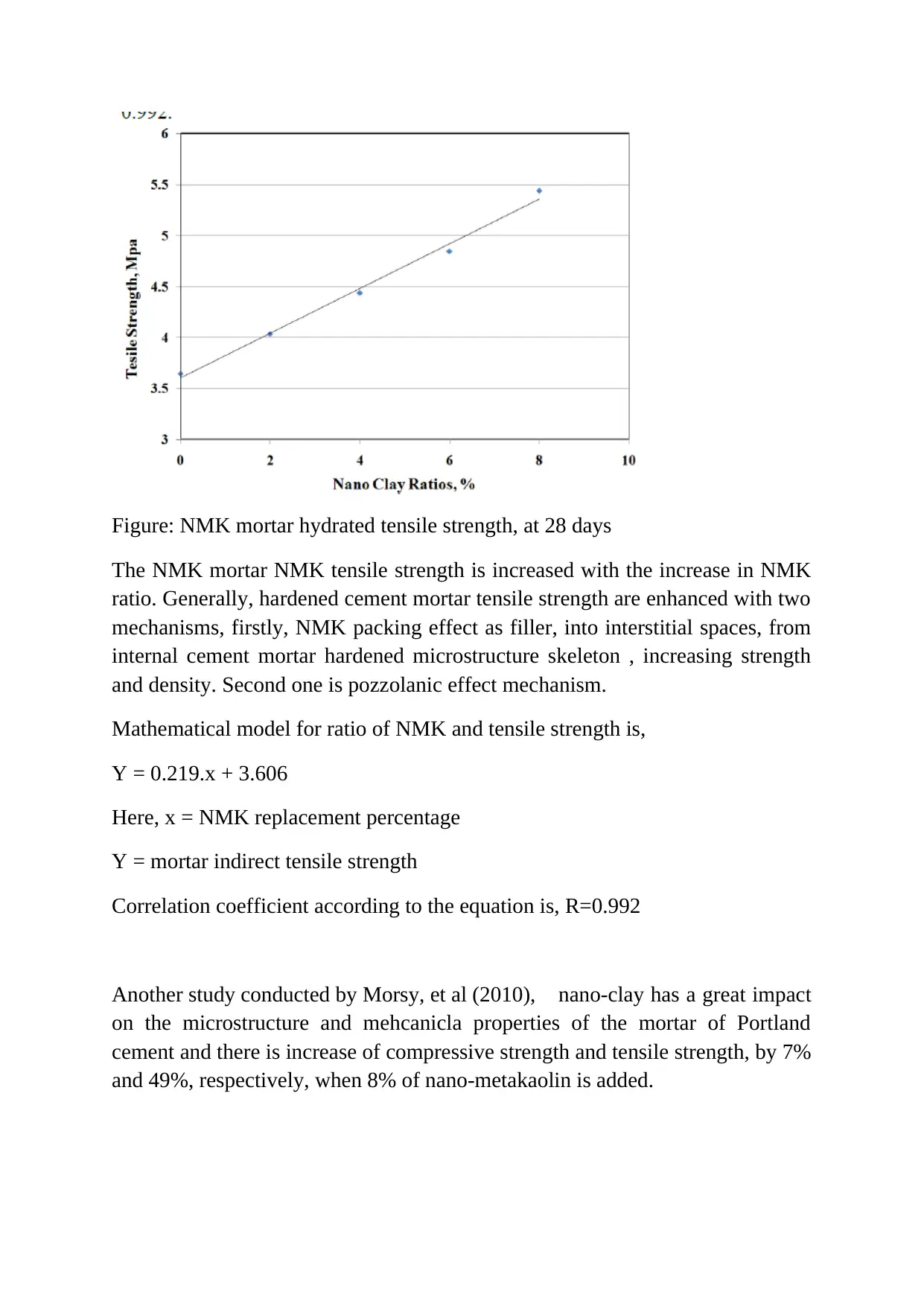
Figure: NMK mortar hydrated tensile strength, at 28 days
The NMK mortar NMK tensile strength is increased with the increase in NMK
ratio. Generally, hardened cement mortar tensile strength are enhanced with two
mechanisms, firstly, NMK packing effect as filler, into interstitial spaces, from
internal cement mortar hardened microstructure skeleton , increasing strength
and density. Second one is pozzolanic effect mechanism.
Mathematical model for ratio of NMK and tensile strength is,
Y = 0.219.x + 3.606
Here, x = NMK replacement percentage
Y = mortar indirect tensile strength
Correlation coefficient according to the equation is, R=0.992
Another study conducted by Morsy, et al (2010), nano-clay has a great impact
on the microstructure and mehcanicla properties of the mortar of Portland
cement and there is increase of compressive strength and tensile strength, by 7%
and 49%, respectively, when 8% of nano-metakaolin is added.
The NMK mortar NMK tensile strength is increased with the increase in NMK
ratio. Generally, hardened cement mortar tensile strength are enhanced with two
mechanisms, firstly, NMK packing effect as filler, into interstitial spaces, from
internal cement mortar hardened microstructure skeleton , increasing strength
and density. Second one is pozzolanic effect mechanism.
Mathematical model for ratio of NMK and tensile strength is,
Y = 0.219.x + 3.606
Here, x = NMK replacement percentage
Y = mortar indirect tensile strength
Correlation coefficient according to the equation is, R=0.992
Another study conducted by Morsy, et al (2010), nano-clay has a great impact
on the microstructure and mehcanicla properties of the mortar of Portland
cement and there is increase of compressive strength and tensile strength, by 7%
and 49%, respectively, when 8% of nano-metakaolin is added.
⊘ This is a preview!⊘
Do you want full access?
Subscribe today to unlock all pages.

Trusted by 1+ million students worldwide
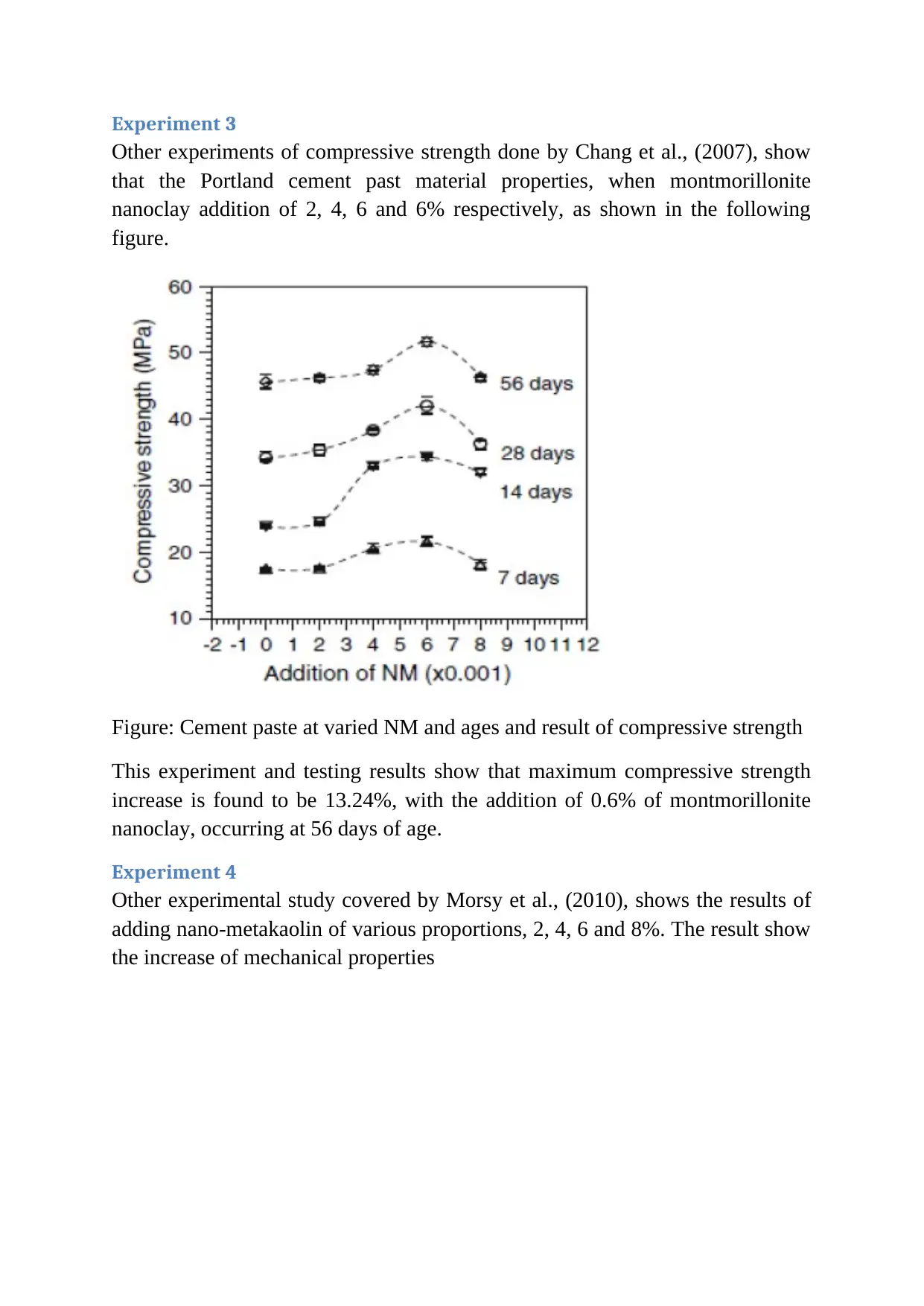
Experiment 3
Other experiments of compressive strength done by Chang et al., (2007), show
that the Portland cement past material properties, when montmorillonite
nanoclay addition of 2, 4, 6 and 6% respectively, as shown in the following
figure.
Figure: Cement paste at varied NM and ages and result of compressive strength
This experiment and testing results show that maximum compressive strength
increase is found to be 13.24%, with the addition of 0.6% of montmorillonite
nanoclay, occurring at 56 days of age.
Experiment 4
Other experimental study covered by Morsy et al., (2010), shows the results of
adding nano-metakaolin of various proportions, 2, 4, 6 and 8%. The result show
the increase of mechanical properties
Other experiments of compressive strength done by Chang et al., (2007), show
that the Portland cement past material properties, when montmorillonite
nanoclay addition of 2, 4, 6 and 6% respectively, as shown in the following
figure.
Figure: Cement paste at varied NM and ages and result of compressive strength
This experiment and testing results show that maximum compressive strength
increase is found to be 13.24%, with the addition of 0.6% of montmorillonite
nanoclay, occurring at 56 days of age.
Experiment 4
Other experimental study covered by Morsy et al., (2010), shows the results of
adding nano-metakaolin of various proportions, 2, 4, 6 and 8%. The result show
the increase of mechanical properties
Paraphrase This Document
Need a fresh take? Get an instant paraphrase of this document with our AI Paraphraser
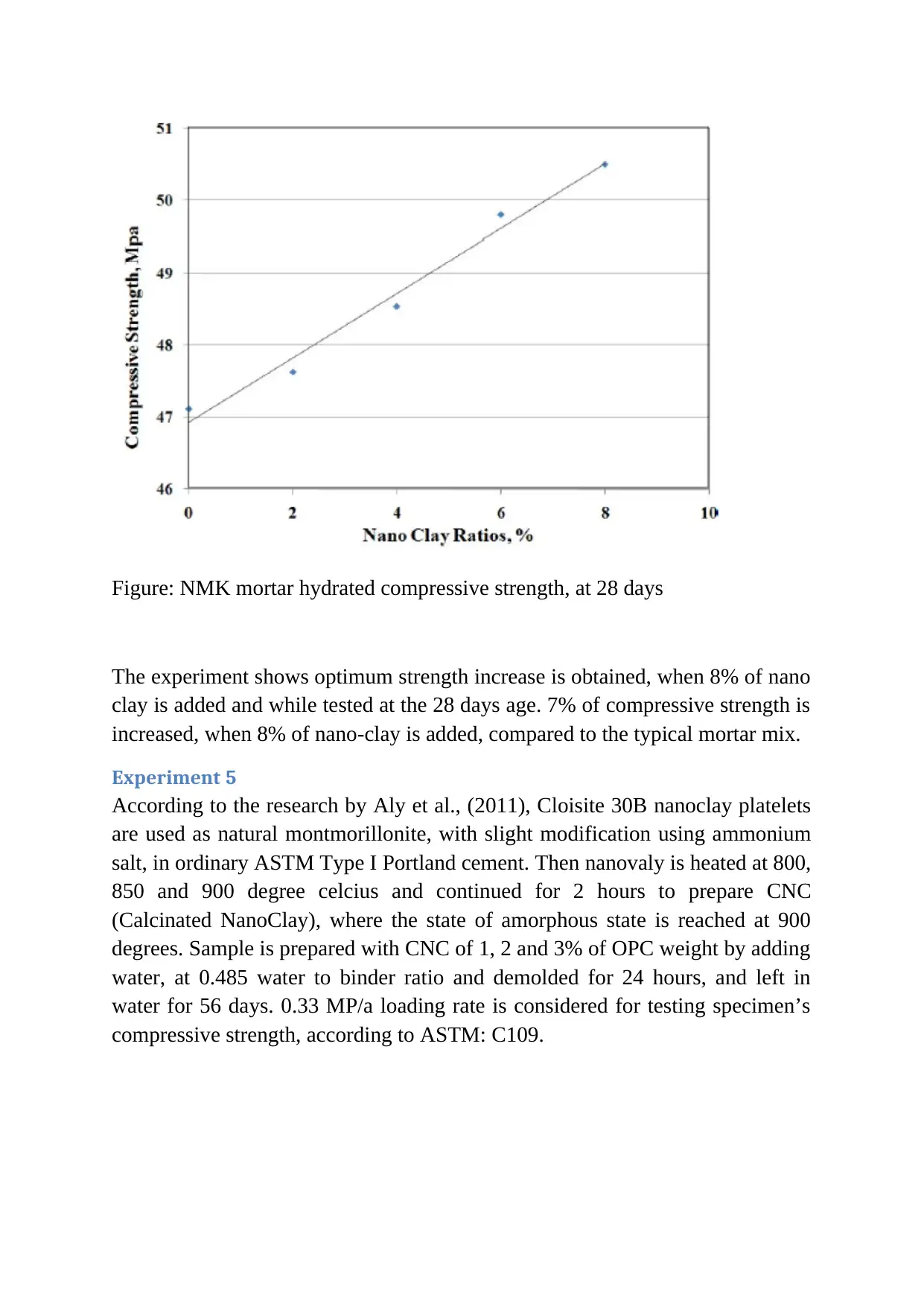
Figure: NMK mortar hydrated compressive strength, at 28 days
The experiment shows optimum strength increase is obtained, when 8% of nano
clay is added and while tested at the 28 days age. 7% of compressive strength is
increased, when 8% of nano-clay is added, compared to the typical mortar mix.
Experiment 5
According to the research by Aly et al., (2011), Cloisite 30B nanoclay platelets
are used as natural montmorillonite, with slight modification using ammonium
salt, in ordinary ASTM Type I Portland cement. Then nanovaly is heated at 800,
850 and 900 degree celcius and continued for 2 hours to prepare CNC
(Calcinated NanoClay), where the state of amorphous state is reached at 900
degrees. Sample is prepared with CNC of 1, 2 and 3% of OPC weight by adding
water, at 0.485 water to binder ratio and demolded for 24 hours, and left in
water for 56 days. 0.33 MP/a loading rate is considered for testing specimen’s
compressive strength, according to ASTM: C109.
The experiment shows optimum strength increase is obtained, when 8% of nano
clay is added and while tested at the 28 days age. 7% of compressive strength is
increased, when 8% of nano-clay is added, compared to the typical mortar mix.
Experiment 5
According to the research by Aly et al., (2011), Cloisite 30B nanoclay platelets
are used as natural montmorillonite, with slight modification using ammonium
salt, in ordinary ASTM Type I Portland cement. Then nanovaly is heated at 800,
850 and 900 degree celcius and continued for 2 hours to prepare CNC
(Calcinated NanoClay), where the state of amorphous state is reached at 900
degrees. Sample is prepared with CNC of 1, 2 and 3% of OPC weight by adding
water, at 0.485 water to binder ratio and demolded for 24 hours, and left in
water for 56 days. 0.33 MP/a loading rate is considered for testing specimen’s
compressive strength, according to ASTM: C109.
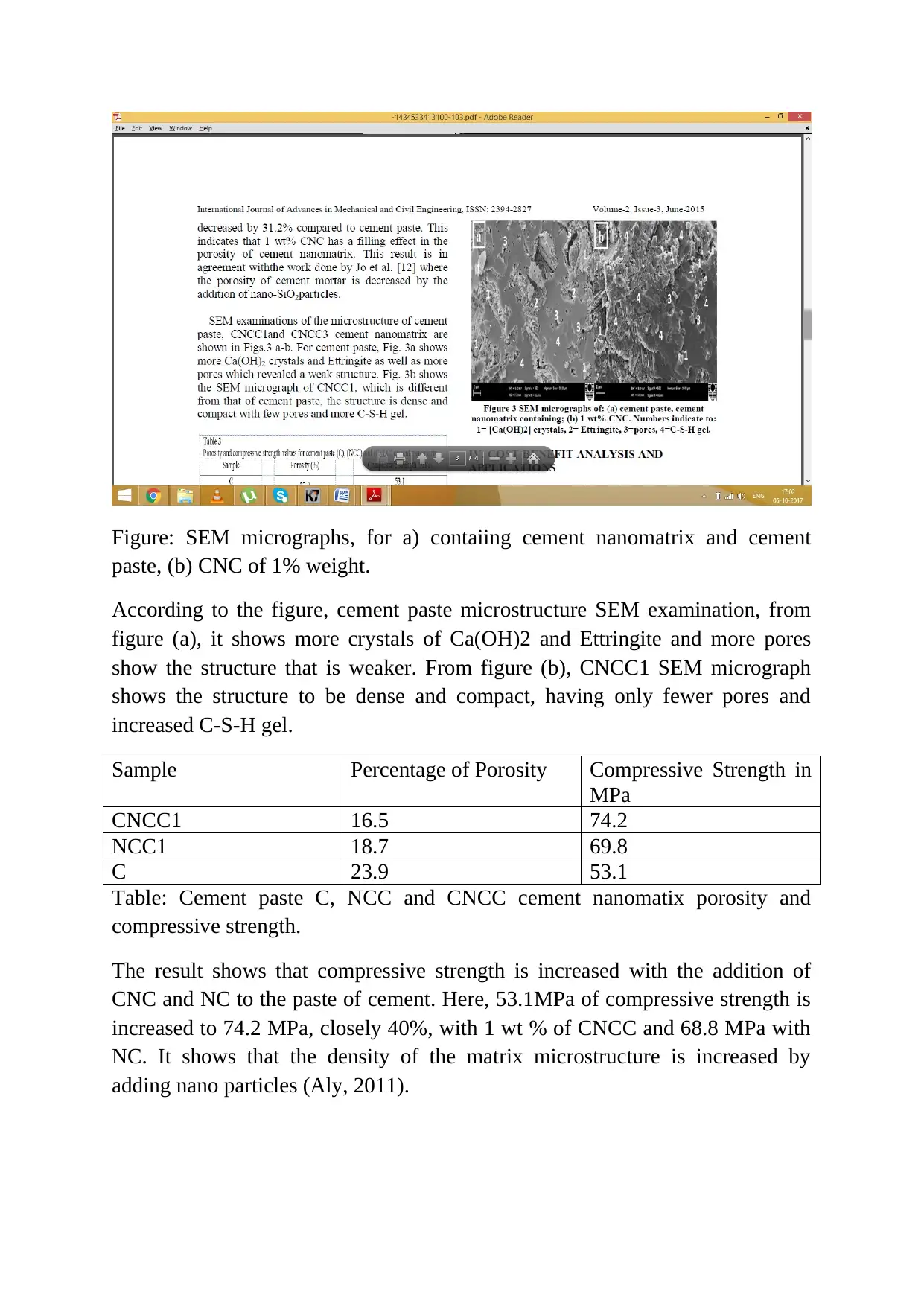
Figure: SEM micrographs, for a) contaiing cement nanomatrix and cement
paste, (b) CNC of 1% weight.
According to the figure, cement paste microstructure SEM examination, from
figure (a), it shows more crystals of Ca(OH)2 and Ettringite and more pores
show the structure that is weaker. From figure (b), CNCC1 SEM micrograph
shows the structure to be dense and compact, having only fewer pores and
increased C-S-H gel.
Sample Percentage of Porosity Compressive Strength in
MPa
CNCC1 16.5 74.2
NCC1 18.7 69.8
C 23.9 53.1
Table: Cement paste C, NCC and CNCC cement nanomatix porosity and
compressive strength.
The result shows that compressive strength is increased with the addition of
CNC and NC to the paste of cement. Here, 53.1MPa of compressive strength is
increased to 74.2 MPa, closely 40%, with 1 wt % of CNCC and 68.8 MPa with
NC. It shows that the density of the matrix microstructure is increased by
adding nano particles (Aly, 2011).
paste, (b) CNC of 1% weight.
According to the figure, cement paste microstructure SEM examination, from
figure (a), it shows more crystals of Ca(OH)2 and Ettringite and more pores
show the structure that is weaker. From figure (b), CNCC1 SEM micrograph
shows the structure to be dense and compact, having only fewer pores and
increased C-S-H gel.
Sample Percentage of Porosity Compressive Strength in
MPa
CNCC1 16.5 74.2
NCC1 18.7 69.8
C 23.9 53.1
Table: Cement paste C, NCC and CNCC cement nanomatix porosity and
compressive strength.
The result shows that compressive strength is increased with the addition of
CNC and NC to the paste of cement. Here, 53.1MPa of compressive strength is
increased to 74.2 MPa, closely 40%, with 1 wt % of CNCC and 68.8 MPa with
NC. It shows that the density of the matrix microstructure is increased by
adding nano particles (Aly, 2011).
⊘ This is a preview!⊘
Do you want full access?
Subscribe today to unlock all pages.

Trusted by 1+ million students worldwide
1 out of 31
Related Documents
Your All-in-One AI-Powered Toolkit for Academic Success.
+13062052269
info@desklib.com
Available 24*7 on WhatsApp / Email
![[object Object]](/_next/static/media/star-bottom.7253800d.svg)
Unlock your academic potential
Copyright © 2020–2025 A2Z Services. All Rights Reserved. Developed and managed by ZUCOL.



